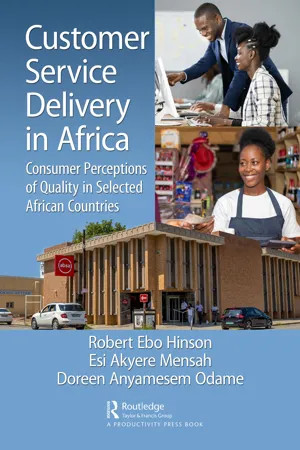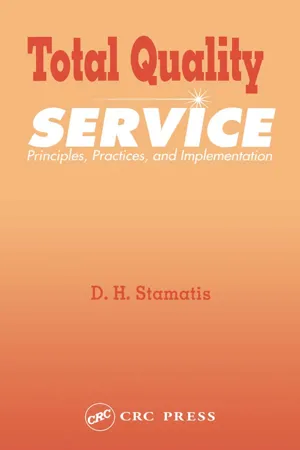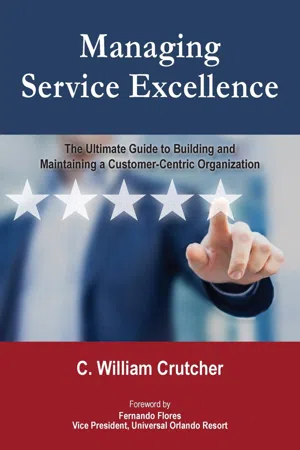Business
Good Customer Service
Good customer service involves providing a positive experience for customers by meeting their needs and exceeding their expectations. This includes being responsive, knowledgeable, and courteous, as well as resolving issues promptly and effectively. Ultimately, good customer service builds trust and loyalty, leading to repeat business and positive word-of-mouth referrals.
Written by Perlego with AI-assistance
Related key terms
Related key terms
1 of 4
Related key terms
1 of 3
5 Key excerpts on "Good Customer Service"
- eBook - ePub
- Marty Brounstein(Author)
- 2011(Publication Date)
- For Dummies(Publisher)
You’ve probably seen statistics that say the cost of attracting and gaining new customers is far greater than the cost of keeping them. But if you don’t provide customers with quality service, they may not come back for more.I define quality customer service as adding value to the product or service a business offers, especially people value. This valuing (or not valuing) of people occurs more often at the points of contact, the interactions during which a customer seeks service. If the customer finds the help at those points of contact to be consistently respectful, responsive, accurate, efficient, and reliable, quality service is achieved — the people value shows and satisfies the customer.The following sections provide you with the thinking and communication actions that help you deliver quality customer service consistently. If customers get good service only some of the time, the service isn’t good at all. When customers can count on every interaction being positive, you have quality service working well.Following the Golden Rule
The tools of active listening and assertive speaking play a major role in delivering quality customer service. You begin the effort by thinking like a customer. Actually, doing so shouldn’t be hard because you’ve been a customer for many years yourself.In workshops I’ve done on customer service, I ask participants to list the behaviors they’ve experienced as customers that they consider to be examples of good service. Here are some of the more common examples mentioned: - eBook - ePub
Customer Service Delivery in Africa
Consumer Perceptions of Quality in Selected African Countries
- Robert Ebo Hinson, Esi Akyere Mensah, Doreen Anyamesem Odame(Authors)
- 2024(Publication Date)
- Productivity Press(Publisher)
Chapter 3 Customer Service in GhanaDOI: 10.4324/9781032688466-3Building a good customer experience does not happen by accident, it happens by design.Clare MuscuttBy the end of this chapter, you will be able to:- Understand the dynamics of customer service in Ghana.
- Know the state of customer service of different business sectors in Ghana.
- Identify gaps in customer service in Ghana.
- Understand strategies to improve customer service in Ghana.
Chapter Outline
- Customer service in Ghana
- Customer service as competitive advantage
- What was the state of customer service delivery in Ghana?
- Customer service delivery gaps in Ghana
- How to bolster customer service in Ghana
- Reference
Customer Service as Competitive Advantage
In the service industry, successful businesses need a competitive advantage in customer service (Hinson, Mohammed, & Mensah, 2006 ). There is the need to have unwavering loyalty from their customers to stay competitive. Customer service is one of the most recognised concepts in service management. Customer service is the act of taking care of the customer’s needs by providing and delivering professional, helpful, high-quality service and assistance before, during, and after the customer’s requirements are met. The customer is the lifeline to the existence of any organisation, and as such, businesses without happy customers will not be profitable medium to long term. In this regard, happy customers are considered as one of the most important assets of every company. Great customer service is thus considered as the essence of successful businesses. Customer service is important to service institutions because an efficient rendering of customer service reduces customers’ claims and negative word of mouth and builds customer loyalty.As explained earlier, in today’s competitive service economy, great customer service is considered as the essence of successful businesses. The global economy has experienced a shift towards the service industry, and customer service is considered as one of the critical techniques to be utilised in the achievement of sustainable competitive advantage. Customer centricity is no longer a luxury but an essential requirement for institutional longevity in today’s competitive marketplace. - eBook - ePub
Total Quality Service
Principles, Practices, and Implementation
- D.H. Stamatis(Author)
- 2018(Publication Date)
- Routledge(Publisher)
This relates directly to the acronym COMFORT (introduced earlier) to signify the importance of service. Recall that COMFORT was defined as caring, observant, mindful, friendly, obliging, responsible, and tactful. These characteristics are the most basic attributes of customer service; without them, there can be no true service of any kind. They all depend on interpersonal skills, communication, empowerment, knowledge, sensitivity, understanding, and some kind of external behavior.Caring shows that indeed you are very much interested in what the customer has to say. You may spend time with the customer to find out what his or her real needs, wants, and expectations are. It is not unusual to even tell the customer that you may not be able to help, at the expense of losing the sale. Furthermore, you may go as far as suggesting someone else or some other company.You must be observant. In most cases when dealing with service-related items, observations may contribute to satisfying the customer more than direct communication. Pay attention to body language and mannerisms and, if necessary, read between the lines. Always try to be one step ahead of the customer. Anticipate his or her action. Actively listen to what the customer is communicating as well as—and perhaps more importantly—what he or she is not communicating.You must be mindful. Remember that you and your organization exist to satisfy the customer. Without the customer’s need, you do not have a job nor does the organization have a service to provide. The customer has a choice, and as such, if you or the organization does not recognize the urgency, the sensitivity, the uniqueness, the expectations, and the influence that the customer has, you will not be successful in satisfying the customer.You must be friendly. Friendliness does not mean being a pest. Offer guidance and information, and let the customer know you are there to help. If you have to, provide feedback to help the customer make his or her decision. If you do provide feedback, be truthful. For example, someone comes into your retail clothing store, walks around, picks up some clothing, and tries it on. As a salesperson, you may advise the customer about fit and answer any questions that the customer may have. - eBook - ePub
Managing Service Excellence
The Ultimate Guide to Building and Maintaining a Customer-Centric Organization
- C. William Crutcher(Author)
- 2017(Publication Date)
- Diamin Publishing(Publisher)
Have you ever been to a restaurant where your server appeared to not know their menu? While we should certainly appreciate the learning curve for new employees, it becomes frustrating when the server responds to every inquiry with “Let me check.” The server should take the time to learn what’s on the menu and what substitutions or modifications can be made. Lack of knowledge about your products or services does not instill confidence in your customers.The third root of service is empowerment. It is frustrating for customers to deal with employees who are not able to resolve service issues. As the customer service professional, it is essential that you know what latitude you have to serve your customers. When there is a service breakdown, do you have to “check with the boss” or are you able to offer alternatives to the customer?How good does it make you feel as a customer when an employee offers you some reward, on the spot, for a service breakdown? You quickly understand that the business values its customers. Naturally, some organizations allow their employees greater autonomy than others. If empowerment is lacking though, and employees regularly need permission before taking a course of action, the service professional has the opportunity to reflect positive strategies to leadership that will, hopefully, influence greater empowerment.Who Are Your Customers?Simply defined, A customer is any person or group to whom you provide a good or service.Typically, when we think of a customer, we think of the person or group paying for that service or product. This could be the family receiving their meals at the restaurant, the person getting a car loan at the bank or a business having the roof replaced on their headquarters building. Each transaction involves a product or service and one or more customers.Your view is likely that those who pay the bills—external customers—are your only true customers. But often disregarded as a customer is the person who works down the hall from you, or in another department or building of your company.If you’re not serving the bill-paying customer, you’d better be serving someone who is!—NUMEROUS ATTRIBUTIONSEvery employee has customers, whether external or internal to the organization, or both. If a person does not create something that is or could be used by another, then why would that job exist? The report generated by the finance department, the supplies ordered by the office clerk and even the restrooms cleaned by the custodian all contribute to the marketable outputs of the organization. While some jobs may be more directly linked to the external customer, everyone in the organization must work together effectively to retain that customer-focused competitive advantage. - eBook - ePub
- Keith Porter, Paul Smith, Roger Fagg(Authors)
- 2007(Publication Date)
- Routledge(Publisher)
The idea of customer service is made up of a number of components. We have already identified that customers have many and varied needs, so how might these be met through customer service standards?A customer expects reliability in the product or service offered. Reliability is crucial to the customers of transport operators – the customer expects the bus to turn up at the advertised time. Consistency of product is essential too – the customer expects each packet of cornflakes to taste the same.Responsiveness is another aspect of customer service. The organization needs to be responsive to the needs of its customers. If customers are telling the supplier that something is wrong with the product or service, or phoning a helpline with similar complaints, then the supplier needs to take action. The supplier needs to demonstrate to customers that it is listening to what they are saying and taking appropriate action.It should go without saying that the customer expects the supplier to be competent in the service or product it is delivering. There is an expectation that car mechanics have had relevant training and understand the operation of particular vehicles before they service your car. Likewise, a customer should be able to expect a window cleaner to be competent to do a good job, and a chef to prepare edible meals. Should the supplier prove to be incompetent in delivering the service or product, then levels of customer satisfaction will decline and customers will seek alternative suppliers.Customer service should be accessible to customers and potential customers. A product that is not on the supermarket shelves is not accessible. A service that is not advertised in some way is not accessible. The organization needs to consider factors such as marketing and merchandising to ensure accessibility to the widest range of potential customers.Another way of looking at the idea of accessibility to customer services is to consider how customers and potential customers can communicate with the supplier. Are helpline phone numbers readily available? Is the helpline manned 24 hours a day, or only at certain specific times? Has the organization thought about the needs of people who, for example, may be visually impaired?
Index pages curate the most relevant extracts from our library of academic textbooks. They’ve been created using an in-house natural language model (NLM), each adding context and meaning to key research topics.
Explore more topic indexes
Explore more topic indexes
1 of 6
Explore more topic indexes
1 of 4




